Larnaka
...the ancient city of Kition!
Larnaka is the oldest continuously inhabited city in Cyprus. The city-kingdom of Kition (in present-day Larnaca) was abandoned sometime after the earthquake of 342. Other ancient cities of Cyprus were abandoned by their inhabitants.
Chronology
BC (Before Christ)
10000 – 8200BC: Larnaka boasts one of the few places in Cyprus that can show evidence of life during the Pre-Neolithic period. Just a few kilometers from Larnaka, near the village of Agia Anna, the bones of local primitives were discovered.
8200 - 3900 BC: Chirokitia is considered to be the first 'urban' settlement in Europe and is recognized by UNESCO.
40th century BC: It is believed that Noah’s grandson, Khittim, established the first settlement.
13th century BC: The city-kingdom of Kition (Larnaka) was originally established. Kition hosted the great Greek - Mycenaean colonization.
1200 – 1000 BC: The arrival of Achaeans, a Greek colonist in Kition.
750 – 480 BC: The city kingdom became autonomous and very powerful by the end of the Assyrian dominion in Cyprus.
2nd century BC: Kition prospered in the Hellenistic times under the rule of the Ptolemaic (Empire of Egypt). The last Ptolemaic Queen of Cyprus was Cleopatra the Beautiful.
AD (Anno Domini – The year of our Lord)
649 AD: The Arab – Islamic (Arabians) attempt to occupy Cyprus. Hala Sultan Tekke near the salt lake was founded by the Arabs to honor Um Haram (was the Islamic prophet Muhammad's wet nurse)
1190 – 1486 AD: During the Frankish occupation, Kition began to be called 'L’ Arnica' in French, eventually morphing into Larnaka.
1489 – 1571 AD: The Venetians maximized the exploitation of Larnaka's salt, which they traded with great profit.
1571 – 1878 AD: After the Ottoman invasion, the port of Larnaca remained the most important in Town. In 1625 AD, the castle was reconstructed, as it can be seen today, to serve as the protector of the Larnaka port.
1878 – 1960 AD: The British colonial-style buildings of the palm tree promenade (Finikoudes) and the pier of the Larnaka Marina were constructed a year after the British occupation to serve trade and administration purposes, as the town was still the most important in Cyprus.
1960 AD: The Island’s independence was earned in 1960 and Larnaka had a mixed predominantly Greek Cypriot and Turkish Cypriot population.

 English
English
 Ελληνικά
Ελληνικά Русский
Русский